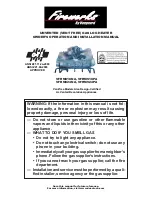
39
Make certain power to the water heater is “OFF” before removing the protective cover FOR
ANY REASON.
Label all wires prior to disconnection when servicing controls. Wiring errors can cause
improper and dangerous operation. VERIFY PROPER OPERATION AFTER SERVICING!
For your safety,
DO NOT
attempt repair of gas piping, gas control burner, vent connectors or
other safety devices. Refer repairs to qualified service personnel.
NOTE: A GHE Training Manual is available through the Technical Services Department for a
more detailed troubleshooting and repair guide.
CAUTION
!
CAUTION
!
CAUTION
!
Before You Call For Service…
Troubleshooting Tips
Save time and money! Review the charts on the following pages first and you may not
need to call for service.
Problem
Possible Cause
What To Do
Unable to light
the main burner
Gas control ploblem
Contact a qualified service technician.
Unit or electrical supply line not properly
grounded
Verify that the electrical supply line and unit have
proper ground connection.
Main burner does not stay lit
Burner flame not contacting sensor rod.
Call a qualified service technician to review flame
rectification.
Unit or electrical supply line not properly
grounded
Verify the electrical supply line and unit have
proper ground connection.
Not enough or no hot water
Water usage exceeded the capacity
Wait for the water heater to recover after an abnor-
mal demand of the water heater.
Low gas pressure
Check the gas supply pressure.
Water heater set point is set too low
See the "User Interface" section of this manual to
the set point temperature.
Leaking or open hot water faucets
Make sure all faucets are closed.
"ON/OFF" switch turned off
Turn the switch to the "ON" position.
Colder supply water
Incoming water temperature might be lower than
when the unit was initially installed. This will
require a longer heat up cycle.
Burner not staying on
Refer to the "Main Burner" section of this manual.
Water is to hot
The water heater set point is set too high See the "User Interface" section of this manual to
the set point temperature.














































